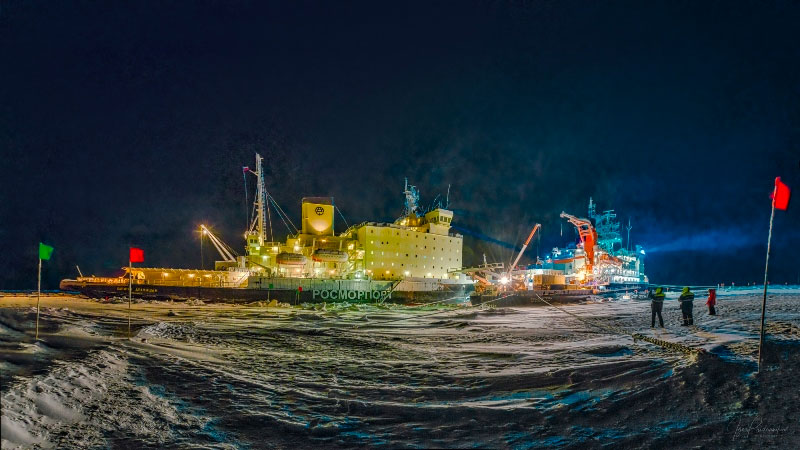Russian icebreaker which resupplied MOSAiC expedition asks for help

After having set historical record in winter ice, Russian icebreaker “Kapitan Dranitsyn” requests assistance for return voyage to mainland.
The 129 meter long diesel-engined vessel on 28th February reached the site of German Arctic research vessel “Polarstern”, a long-awaited encounter for the members of Arctic expedition MOSAiC. On board the Russian ship were researchers and crew that are to replace the personnel that has served in the desolate Arctic ice since mid-December 2019.
Two days before the encounter, the “Kapitan Dranitsyn” had set a world record as it reached the northernmost position ever made by a diesel-engined vessel in winter time.
The “Kapitan Dranitsyn” dropped anchor 970 meters from «Polarstern», moored to the same floe and the handover of personnel and 43 tons of goods soon afterwards started across the frozen water.
The transfer took place at 88°28 North, the Alfred Wegner Institute informs.
Help needed
The operation is part of the MOSAiC research expedition and has been carefully planned for many months. But not everything went as planned.
The Russian icebreaker experienced extreme hardships on its way north. The ship set out from Tromsø, Norway, on the 3rd of February and encountered highly difficult conditions as it later made it through the ice.
Ice thickness in parts of the area is as much as 160 cm and several places pack ice hummocks have grown several meters tall.
Repeatedly, the ship had to wait for improved weather and ice conditions, change course and circumvent extreme icy parts. On some of the days, the icebreaker managed to sail only 20 miles per day, a distance it normally manages to break through in a couple of hours, ship owner Rosmorport informs.
Following the difficult voyage, the “Kapitan Dranitsyn” has consumed far more fuel than planned and now needs assistance to make it back to the Russian mainland.
According to the Alfred Wegner Institute, it is icebreaker “Admiral Makarov” that is to come to the assistance of the “Kapitan Dranitsyn”. The former will bring the extra fuel needed.

Return to Tromsø
The “Kapitan Dranitsyn” on the 4th March left the site of the “Polarstern” and set course for Tromsø. On board is not only returning researchers and crew members but also collected research materials that now are to undergo additional analysis.
As of the 4th of March, the “Admiral Makarov” was still moored in Murmansk, ship tracking data indicate.
It is not the first time that the “Kapitan Dranitsyn” is experiencing ice conditions that are beyond the limits of its capacities. In the winter of 2018, the icebreaker got ice-locked for several months as it delivered goods to the east Arctic town of Pevek.
Biggest Arctic expedition
On board the “Polarstern” are more than 120 people, including several teams of researchers that have been preparing for the voyage for several years. It is the most comprehensive Arctic expedition ever, with a total budget of more than €140 million.
The ship, a German-built icebreaker operated by the Alfred Wegener Institute for Polar and Marine Research (AWI), in early October 2019 sailed deep into the ice and has subsequently drifted with the ice.
In the course of the expedition, up to 600 experts will be on board the vessel, and be exchanged in phases. In addition, around 300 people will work in the background to make the expedition possible.
Representatives of 19 countries take part in the MOSAiC.
Ice air strip
Four icebreakers from Russia, Sweden and China are planned to assist the “Polarstern” in the course of the year. Among them will be the new Chinese icebreaker “Xue Long 2″. In spring 2020, a landing strip will be built on the Arctic ice, to serve German research aircrafts Polar 5 and Polar 6.
On board the “Polarstern” are snowcats that lately has prepared the 900 meter long landing strip that is planned used for aircraft. The next shift of crew and personnel is likely to be done by aircraft, the expedition members say.
The MOSAiC will contribute to a quantum leap in our understanding of the coupled Arctic climate system and its representation in global climate models, lead scientist Markus Rex said in a presentation in May 2019.
It is now Professor Torsten Kanzow from the Alfred Wegener Institute that is in charge as Chief Scientist on board. Kanzow last week arrived to site by helicopter.
Related stories from around the North:
Antarctica: Do the extreme conditions of Antarctica change the human brain?, Eye on the Arctic
Canada: Canada’s new Arctic patrol ships could be tasked with hurricane relief, CBC News
Finland: Finland’s aging icebreaker fleet needs modernization, Yle News
Germany: MOSAiC international science expedition completes crew transfer in Central Arctic, Eye on the Arctic
Greenland: Documentary will show climate change through eyes of pioneering scientist, Mia Bennett – Blog
Iceland: Geoengineering climate fixes popular at Arctic Circle assembly, Mia Bennett – Blog
Norway: Twin science projects seek to understand impacts of Arctic climate change, Radio Canada International
Russia: In a last move as PM, Medvedev secured funding to first Russian Lider-class icebreaker, The Independent Barents Observer
Sweden: Over 11,000 scientists sign statement warning of climate emergency, Radio Sweden
United Kingdom: UK’s new flagship polar research vessel officially named Sir David Attenborough, Eye on the Arctic
United States: New U.S. icebreaker will focus on Antarctic, says Coast Guard boss, Alaska Public Media



